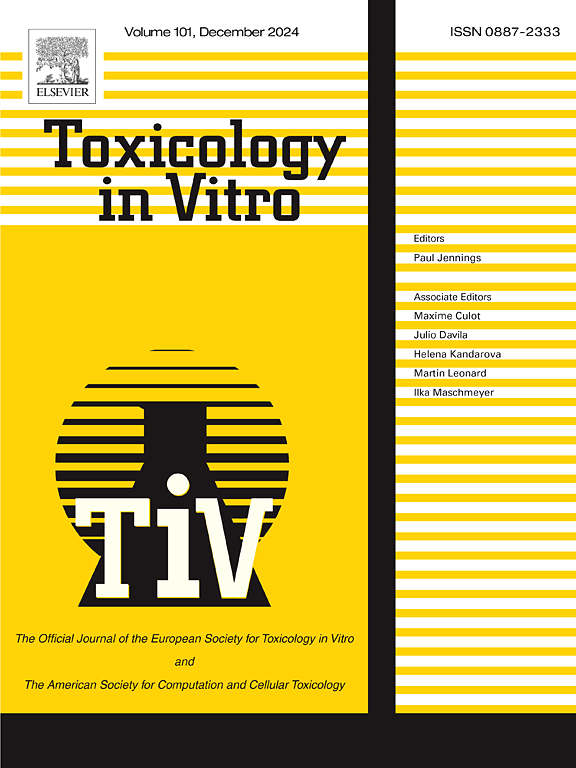基因内抗菌肽 Hs02 对白血病细胞株的毒性与特定热解成分的表达增加有关。
IF 2.6
3区 医学
Q3 TOXICOLOGY
引用次数: 0
摘要
据报道,一些抗菌肽具有抗癌潜力。Hs02 是最近表征的一种基因内抗菌肽(IAP),它能够表现出强大的抗菌和抗炎作用。在这项研究中,我们首次使用代表主要白血病类型的细胞系作为癌症模型,评估了 Hs02 IAP 的抗肿瘤潜力。有趣的是,在相同浓度下,这种肽能降低几种白血病细胞系的存活率,而不影响 PBMC 的存活率。在 HL-60 细胞系中,用 Hs02 处理会控制细胞分裂,导致细胞停滞在细胞周期的 G1 阶段。更重要的是,经 Hs02 处理的 HL-60 细胞会发生细胞死亡,质膜上形成孔隙并释放 LDH。相应地,Hs02 处理刺激了 NLRP1、CASP-1、GSDME 和 IL-1β 等参与化脓过程的成分的表达。综上所述,我们的数据描述了 Hs02 的抗肿瘤潜力,为评估该肽在其他癌症模型中的抗肿瘤潜力以及将该分子用作具有抗癌治疗潜力的新肽的模板提供了机会。本文章由计算机程序翻译,如有差异,请以英文原文为准。
Intragenic antimicrobial peptide Hs02 toxicity against leukemia cell lines is associated with increased expression of select pyroptotic components
The anticancer potential of some antimicrobial peptides has been reported. Hs02 is a recently characterized Intragenic Antimicrobial Peptide (IAP), which was able to exhibit potent antimicrobial and anti-inflammatory action. In this study, we evaluate for the first time the antineoplastic potential of the Hs02 IAP using cell lines representing the main types of leukemia as cancer models. Interestingly, this peptide decreased the viability of several leukemic cell lines, without compromising the viability of PBMCs in the same concentration. In the HL-60 line, treatment with Hs02 controlled cell division, leading to cell arrest in the G1 phase of the cell cycle. More importantly, HL-60 cells treated with Hs02 undergo cell death, with the formation of pores in the plasma membrane and the release of LDH. Accordingly, Hs02 treatment stimulated the expression of components involved in pyroptosis, such as NLRP1, CASP-1, GSDME, and IL-1β. Taken together, our data characterize the antineoplastic potential of Hs02 and open an opportunity for both evaluating the peptide's antineoplastic potential in other cancer models and using this molecule as a template for new peptides with therapeutic potential against cancer.
求助全文
通过发布文献求助,成功后即可免费获取论文全文。
去求助
来源期刊

Toxicology in Vitro
医学-毒理学
CiteScore
6.50
自引率
3.10%
发文量
181
审稿时长
65 days
期刊介绍:
Toxicology in Vitro publishes original research papers and reviews on the application and use of in vitro systems for assessing or predicting the toxic effects of chemicals and elucidating their mechanisms of action. These in vitro techniques include utilizing cell or tissue cultures, isolated cells, tissue slices, subcellular fractions, transgenic cell cultures, and cells from transgenic organisms, as well as in silico modelling. The Journal will focus on investigations that involve the development and validation of new in vitro methods, e.g. for prediction of toxic effects based on traditional and in silico modelling; on the use of methods in high-throughput toxicology and pharmacology; elucidation of mechanisms of toxic action; the application of genomics, transcriptomics and proteomics in toxicology, as well as on comparative studies that characterise the relationship between in vitro and in vivo findings. The Journal strongly encourages the submission of manuscripts that focus on the development of in vitro methods, their practical applications and regulatory use (e.g. in the areas of food components cosmetics, pharmaceuticals, pesticides, and industrial chemicals). Toxicology in Vitro discourages papers that record reporting on toxicological effects from materials, such as plant extracts or herbal medicines, that have not been chemically characterized.
 求助内容:
求助内容: 应助结果提醒方式:
应助结果提醒方式:


